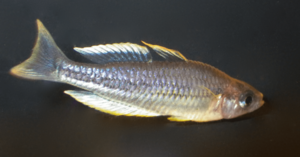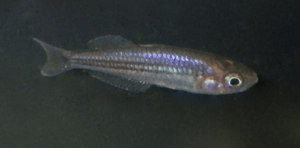Pygmy rainbowfish facts for kids
Quick facts for kids Pygmy rainbowfish |
|
|---|---|
 |
|
| Conservation status | |
| Scientific classification |
The pygmy rainbowfish (Melanotaenia pygmaea) is a small, colorful fish. It belongs to a group of fish called rainbowfish. This special fish is found only in Australia. It is a unique part of Australia's freshwater wildlife.
Contents
Where Does the Pygmy Rainbowfish Live?
The pygmy rainbowfish lives in freshwater environments. It prefers warm, tropical climates. You can find these fish swimming near the bottom or in the middle parts of the water. They are native to northwestern Australia.
How Big Do Pygmy Rainbowfish Get?
These fish are quite small, living up to their "pygmy" name!
- Male pygmy rainbowfish can grow up to about 5.5 centimeters (2.1 inches) long.
- Female pygmy rainbowfish are a bit smaller, reaching about 3.5 centimeters (1.37 inches).
- On average, most pygmy rainbowfish are around 4 centimeters (1.57 inches) long. That's about the length of your pinky finger!
Where Can You Find Pygmy Rainbowfish?
The pygmy rainbowfish naturally lives in specific parts of Australia.
- They are found in the Prince Regent River area.
- They also live in the West Kimberley district.
- All these places are in northwestern Australia.
Pygmy Rainbowfish Life and Habits
Pygmy rainbowfish love to live in fast-flowing streams. They often gather in deep pools. You might also find them at the bottom of waterfalls. These fish prefer areas with rocky bottoms. They usually avoid places with lots of plants in the water.
Pygmy rainbowfish are very social. They like to swim together in large groups. These groups, called schools, can have 50 or more fish! They can also live well in home aquariums.
Male pygmy rainbowfish are usually more brightly colored than females. They show off vivid, rainbow-like colors. These fish typically have a blue back. Their fins are often a pale yellow color.
Scientists are still learning about what pygmy rainbowfish eat. It is thought that they feed on small insects. They might also eat tiny water plants like algae.
Images for kids




